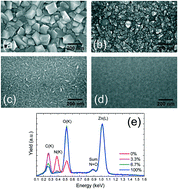Identification of the cubic-to-hexagonal phase transition for the production of stable zinc oxynitride layers
Abstract
Zinc oxynitride layers are becoming popular as semiconductor materials for thin film transistors. However, the formation of these ternary phases with a high N content is challenging because of the different crystalline structures and stability of the binaries involved. In this work, we study both the formation and stability of ternary ZnOxNy phases grown by RF sputtering at different oxygen flux ratios (f). The preferential incorporation of O into the layers is confirmed even for small f values. A singular X-ray amorphous phase is detected for f = 1.7%, denoting the transition towards the hexagonal phase. The exact composition of this phase is accurately determined by elastic recoil detection analysis with a time-of-flight telescope, finding a maximum content of 11% N. For contents below it, all the phases show clear hexagonal signatures in the diffractograms. These hexagonal phases exhibit more than one absorption edge, indicating the formation of a diluted ternary phase into a predominant ZnO matrix. Due to this diluted character of the ternary phase, all the ZnOxNy layers have a remarkable stability in humid environments.



 Please wait while we load your content...
Please wait while we load your content...